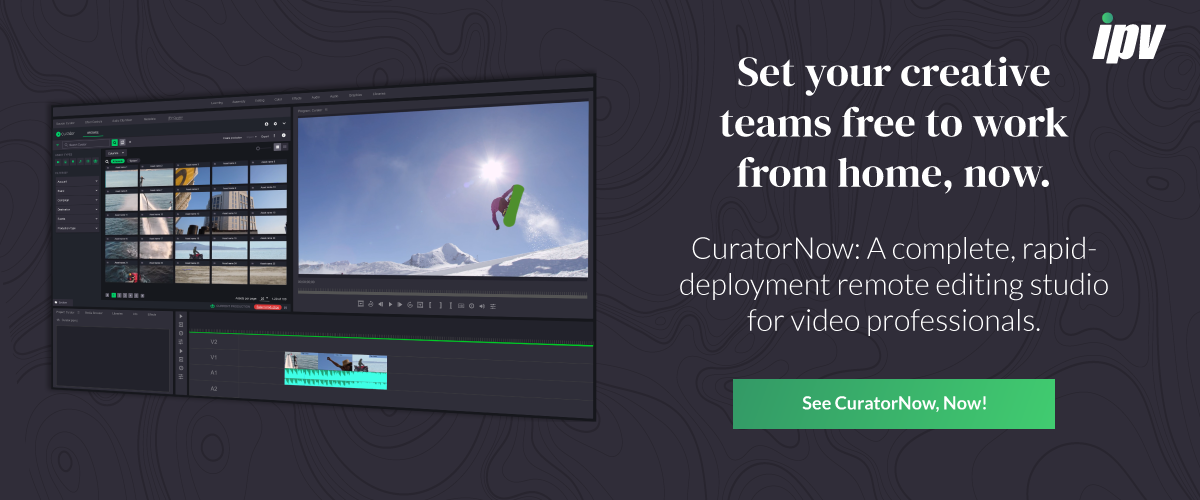
While many companies have utilized some remote work prior to the coronavirus, the sudden shift to a fully remote workforce has mandated a wide range of adaptations.
One area that has caused endless frustration and headaches is managing video files remotely. From sharing, to using proxies and conforming, remote work causes additional challenges at every step when it comes to video creation. The challenge of integrating media into workflows remotely can have devastating consequences for efficiency and the ability of teams to get the job done. But it doesn't have to be this way…
Centralized video in the cloud allows for the most efficient workflow
Being able to centralize everything in the cloud would solve so many problems, but this presents its own set of challenges, ones that can make implementing the changeover from a remote environment seem impossible. Fortunately, media asset management (MAM) has come a long way, and by choosing the right cloud-based software, you will be taking the steps to centralize videos, revolutionizing your ability to use videos in a remote environment.
Let's take a closer look at what challenges media creates for remote work and how an up-to-date MAM can be the solution.
The unique challenges for video
While other industries have tools such as Slack and Trello were built into their daily office life that have translated perfectly to remote work, for those who create videos, having a centralized workforce was likely a critical component of an effective team. The large size of video files, and the nature of collaboration between editors and others such as color graders and sound designers would seem to necessitate being able to work on the project together.
Previously, technology limitations were mastered by having the right equipment on-site — those working remotely are not likely to have access to the same high-powered computers. The inability to centralize video while working remotely creates a host of problems. Decentralization of video to accommodate a remote workforce creates:
- Security risks
- Administrative burdens
- Limitations on access to archived media
- Limitations on technical capabilities based on home equipment
- Workflow interruptions
The advantages of introducing media assets to a centralized cloud
Media asset management had its place before work from home became the default. For the team that was still able to meet in the office, MAM is able to offer well-organized cloud-based storage, or alternatively a hybrid model that allows for a mixture of cloud and on-premises storage (which we’ll cover below). But MAM is not just for storage — it also introduces a wide range of possibilities for remote work, allowing an effective workflow to be generated in a work-from-home scenario. Even better, the MAMs of today have adapted to be implemented quickly and easily.
MAM does not simply centralize video access, creating a parallel to the on-site system but in the cloud. Rather MAM is able to decentralize access to media while centralizing its storage. MAM allows departments to transcend file sharing, making obsolete the need to create new copies for individuals. Members of the team can access archive and production footage directly from a range of devices anywhere.
The hybrid model
Alternatively, you can use a combination of cloud and on-premises storage that offers the benefits of the 100% cloud model while providing even more features that allow for more flexibility. This can help you maximize ROI on existing investments, rather than moving away from on-premises completely.
With the hybrid model, you can process your video assets on-premises without having to upload and move all of your content to the cloud. It still allows for frame-accurate editing via low-res proxies (more on this later) to lower specification computers connected over the internet. This means there is little need for companies to completely switch to cloud and you can save on these costs while still having the option to scale in the future.
The use of proxies
One of the largest challenges to an integrated remote workflow involving video is the use of proxies. With MAM, the proxies are created automatically. Permission settings allow for complete control of what individual team members are allowed to access and the changes they may make.
The advantages MAM offers a remote workforce include:
- Decentralized access to media stored in the cloud
- Multi-user access to a single file
- Automatic proxies creation
- A robust permissions setting system
- The ability to combine centralized and decentralized storage
- Full traceability of edits
How MAM creates solutions
MAM creates a range of solutions for the office situation and especially for remote work, but before going deeper into the many solutions which MAM can provide, it's worth noting that it's likely easier to introduce MAM than you think.
The MAMs of today are easier to implement
While the ability to centralize video storage in the cloud may have always sounded appealing, the challenges of the transition may have been what held you back. But in response to the sudden need to work remotely some MAMs have stepped up, releasing special versions that can be rolled out and implemented in as little as 36 hours — in fact, while we may be biased, we have a MAM that does just that!
What’s more, the increase to efficiency is immediate. For instance, the right MAM will revolutionize the way in which metadata is created and how media is cataloged and searched through using object detection and voice recognition.
MAM integrates directly with editors
Part of what can make MAM such a seamless transition is also central to how it provides solutions. Because MAM integrates directly with editors such as Adobe Premium Pro and Avid Media Managers, the best parts of the previous workflow are maintained while removing the barriers to working in a remote environment.
MAM lets you get the most out of archival footage
MAM creates the opportunity for everyone to have access to all archival media, and makes it easier to search by promoting easier metadata input and making the archives far more searchable. This 'dynamic archive' allows for ideal opportunities to repurpose archival footage.
MAM allows for true collaboration
MAM allows for multi-user access to a single file. This creates opportunities for collaboration that are lacking even in an on-site environment.
MAM increases workflow efficiency
- Easier to implement (particularly MAMs created in response to the remote work situation)
- Integrates directly with editors
- Improves ability to access and use archival media
- Allows better collaboration opportunities
MAM provides new ways of working
MAM will provide new ways for editors to work, but it’s up to them. They can use the file structure they are used to or faceted search, which speeds up the process of finding suitable assets with the use of filters to help editors narrow down what they need. Or they could use a mixture of both in order to get the most out of MAM.
After all, MAM tools aren’t replacing jobs — they are merely a way to enhance how editors work so that processes can become more streamlined.
What to look for when choosing a MAM
Overall MAMs provide advantages for those working on-site as well as remotely, but in the current world where remote work is the default, they have the ability to provide a major lifeline to the industry. If you are looking to make the transition, at a bare minimum, the MAM you choose must be able to:
- Integrate directly with editing software — such as Adobe Premiere Pro, Avid and Blackmagic. This means that there’s no need for editing or production talent to learn completely new ways of working.
- Automate ingest — so videographers and freelancers can immediately get your team the content you need from wherever it’s shot.
- Archive search flexibility — think of how much time archivists and editors have wasted searching through B-roll. If it’s an hour a day at 100k per year, that’s $17,420 per FTE. Can you afford to waste that much time and money?
- Centralize control of archives and production — think about how many people need access to assets to get what they need from remote locations. That means using a cloud or hybrid model to centralize assets and make it easy for editors to find assets quickly and smoothly.
- Allow for remote editing — when you use editors who are remote, being able to easily edit within one source of truth file means there’s less confusion and you can see exactly who’s edited what
- Export directly to platforms — simplify the process of exporting all in one solution without the need for extra unnecessary steps.
However, by choosing the right MAM you can find additional features including:
- Fast roll-out in response to the sudden need to work remotely
- 'Dynamic archive' and improved search functions utilizing abilities such as voice recognition and object detection
- Real-time, cloud-based editing
The coronavirus doesn't mean an end to collaboration and creativity. It’s about finding the right solution that works well with working from home policies and doesn’t compromise quality. If you want to learn more about these technical solutions, check out our Essential Guide to Video Asset Management.
The advantages of this solution, however, are clear. With the right MAM, you can get your team truly back to work, even when it's remote.



Speak Your Mind